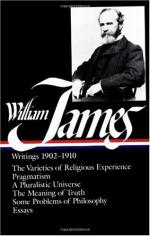|
This section contains 5,748 words (approx. 20 pages at 300 words per page) |

|
SOURCE: "William James, Theodore Dreiser and the 'Anaesthetic Revelation," in American Studies, Vol. 24, No. 1, Spring, 1983, pp. 5-18.
In the following essay, Boren explores the paradox in post-Darwinian American culture between pragmatism and the pervasive sense of doom characteristic of the machine age, embodied by the respective ideas of William James and Theodore Dreiser, and the subsequent experimentations with drugs by both writers.
In 1874 an eccentric amateur philosopher from New York claimed that he had, at last, discovered the key to the mystery of life. The key came with a whiff of laughing gas. In a rather bizarre essay, the author insisted that he and countless others had experienced, while under the influence of nitrous oxide, a mystical revelation of eternal truth. We could, of course, regard such claims as the lunatic swan song of a table-rapping fanatism were it not for the fact that the pamphlet and its...
|
This section contains 5,748 words (approx. 20 pages at 300 words per page) |

|


